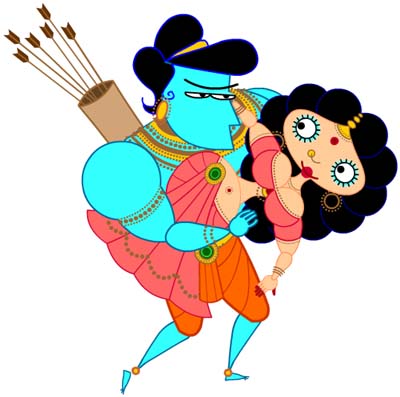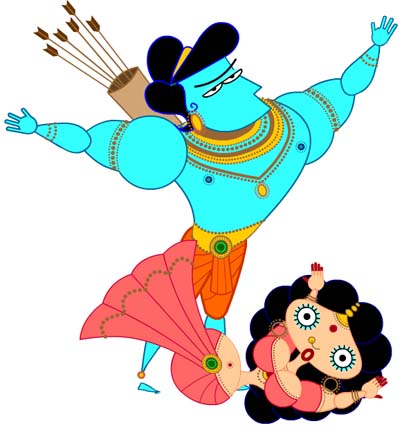
Sita's Adventures
in the Ramayana

Sita's Adventures
in the Ramayana
The Ramayana is as familiar to Indians as the story of Adam and Eve is to Westerners. Both folktale and spiritual myth, there is no one authoritative version; it is retold in countless different and evolving interpretations. From poems and plays to comic books, movies, and novels, there are almost as many versions of the Ramayana as there are Indians.

Written versions of the Ramayana typically comprise thousands of pages. What follows is a very brief synopsis.
The Story of Sita
Sita is born directly from the Earth and found by King Janaka, who recognizes her "celestial beauty" and determines her bride price to be her suitor's "manliness." Thus she is wed to Rama, with whom she falls in love at first sight. She returns with Rama to Ayodhya, where they live luxuriously until Rama's scheming stepmother Kaikeyi connives to have him banished for 14 years. Sita eagerly agrees to stay by her husband's side, and off they go to the forest.Forest life is romantic and pleasant. The luxurious appointments of palace life are traded for bark clothing and simple huts, but Sita, always an earthy type, loves living close to nature. Sita and Rama have many adventures in the forest, meeting sages and vanquishing demons, until one day they are espied by Surpanakha, demon-king Ravana's ugly sister. Surpanakha falls madly in love with Rama, and transforms herself into a beautiful woman in an attempt to seduce him. Instead, Rama makes fun of her and his brother Laxman cuts off her nose. Devastated, Surpanakha reports to Ravana, who pledges revenge on her behalf.
Ravana and his demon friend Mareecha visit Sita and Rama's forest home. Mareecha transforms himself into a beautiful golden deer to captivate Sita, who, as a woman, is inherently vulnerable to shiny pretty things. Sita insists Rama catch the deer, and while he is thus lured from their hut, Ravana makes his move, capturing Sita and spiriting her away in his flying chariot.
Ravana holds Sita captive in Lanka for a year, continually asking her to marry him. Ever chaste and devoted to Rama, Sita rebuffs his every advance, refusing even to sleep under his roof. Instead, she is installed in the palace garden, where she pines for Rama and contemplates suicide. One evening she is secretly visited by the magic moneky warrior Hanuman, who delivers the message that Rama is looking for her. Hanuman instantly becomes as devoted to Sita as he is to Rama, and Sita decides to trust him when he presents her with Rama's signet ring. She tells Hanuman that if Rama doesn't rescue her soon, she will "surely die" by killing herself. Hanuman offers to liberate Sita then and there by carrying her away from Lanka on his back, but she refuses, insisting that only her husband may rightfully rescue her. Later Hanuman declares Sita's purity so powerful she could, if she wanted, burn Ravana to ashes with it and escape on her own, but Sita knows that a woman asserting her own power isn't virtuous.
Rama finally returns with Hanuman and the army of monkey-warriors who lay waste to Lanka. Rama personally vanquishes Ravana in one-on-one combat. Sita is elated - at last reunited with her beloved husband! But Rama rejects her, accusing her of "sleeping in another man's house." Thus Sita throws herself on a funeral pyre in anguish, and her purity is proven when she is spared by the flames.
Rama now embraces Sita and returns with her and Hanuman to Ayodhya, where he assumes his rightful place as king. There they live happily ever after, until Rama hears of a launderer bad-mouthing Sita's chastity behind his back. He responds not by punishing the gossiper, but by banishing Sita from the palace, in secret, with no explanation. Sita is at this time pregnant with twins, but she is nonetheless left for dead in the woods. Fortunately, she is found by the sage Valmiki, who protects her for 14 years while she raises her sons.
Back in Ayodhya, Rama has a golden statue of Sita made to accompany him at functions where a wife is expected. After about 14 years, he hears of the brave young upstarts Lav and Kush. Upon finding them, he identifies them as his sons, and invites them back to Ayodhya. He recognizes Sita as well, but does not embrace her. Sita decides she has suffered enough, and addresses the Earth: "If you are truly my Mother, take me back into your womb!" The Earth then opens up before her, she jumps in, and the fissure seals behind her.
Thus Sita lives and dies as the Ideal Woman.
